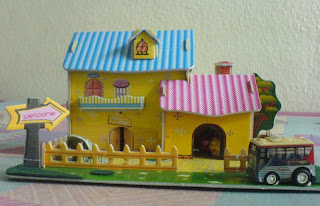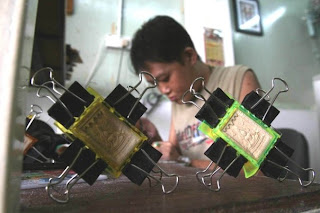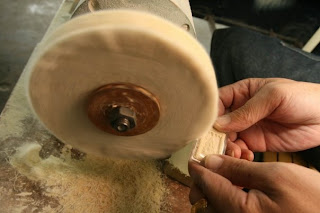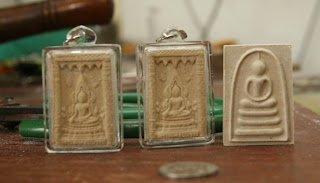Monday, October 18, 2010
Friday, September 17, 2010
The Mistery of World
Fairy Found In England
Nareepol Tree
.
Also called Women Tree, anyway not much information about that, but it is amazing tree that discovered in Thailand.
It is located at Petchaboon province 500kms away from Bangkok. The tree's fruit grow like a human shape, can see from the pictures, like many beautiful ladies hanging and sleeping on the tree.
Nareepol was Thailand language
Naree means : Girl / WomenPol means : Plant / Tree / Fruits.
Therefore Nareepol means : Women Tree
However most of the users on Internet forum are not believed that it is real stories, many feedback indicated that Nareepol Tree is almost certainly nothing more than a hoax.
__________________________________________________________________________________
The Legend of Phra Pidta - Tok Raja
Tok Raja ( Luang Phor Khron ) - "Malaysia King of Pidta"
Many Malaysian have been heard his great name before - Tok Raja, The Master of Shut Eye Buddha ( Phra Pidta ) and he was from Kelantan, Malaysia. He was born on Tuesday, 1st December 1976 ( B.E.2419 ) and sent to Wat ( Temple ) Uttamaram by his parents when he was 12years old to learn Buddhism and Thai language.
Tok Raja is well known in making Phra Pidta Amulet, and well respected by the Sultan of Kelantan, Malaysia, and the King of Thailand.
The conferment of "Tok Raja" bestowed to him by the Sultan of Kelantan.
- Tok ( Malay word ) - mean "Grandfather"
- Raja ( Malay word ) - mean "King"
Tok Raja's Pidta amulets are usually quite big in size which is his speciality, and it has 3-D effect and the amulet actually sits upright when placed on a flat surface.
His amulets contains many special formula including holy powder, latex from certain trees and special wood. He would choose different materials for different purpose in making his amulet. Some of his amulets had his own hand written Yantra on the front and at the back.
In the jungles of Malaysia and Thailand, these is a kind of tree which can release a kind of gas in order to protect itself. In Malaysia, it is called "Paint Tree". This kind of tree has a natural mechanism in protecting itself by release a kind of acidic gas that keeps human beings and animals away. if a human pass by the tree, his body will feel itchy and swollen.
The liquid of "Paint Tree" is red color, but it will turn into black after it dries. If a human being uses his hand to touch the liquid of the tree, he will feel hurt like by hot acid, or his skin will burnt in worst cases. Tok Raja used the liquid from this particular tree to make amulets. He believed that since this kind of tree is good in self-protection, if he used the liquid, together with his own powerful chant int he process of amulet-creation, these amulets would bring great protection and avoidance of danger to the wearer.
Tok Raja's health started to deteriorate from July 1962 ( B.E. 2505 ) onwards. His health was deteriorating significantly after his trip to Singapore. The bad news about his health was spread like wild fire and many people from all over Malaya ( Malaysia ) came to visit him, included the Royal Highness, The Sultan of Kelantan. Due to old age, Tok Raja had passed away on 19th November 1962 ( B.E. 2505 ), 15 days before the conferment of "Chao Khoon" title bestowed to him by The King of Thailand, his Highness King Phumibol Adulyadeth where Tok Raja was invited to be present at the King Palace in Bangkok on 5th December 1962 ( B.E.2505 )
The Legend of Botak Chin
Wong Swee Chin, nickname is Botak Chin, was born in year 1951 in Kuala Lumpur, Malaysia.
He was one of
........................................................
Botak Chin Malaysia's Robin Hood
- Despite popular belief, the word "Botak" in his name does not refer to him being botak (bald). It is actually an acronym for "Bantu Orang Tak Ada Kerja" in Malay words, means helping for poor people, according to Abu Bakar Juah, a former director of Taiping Prison.
Botak Chin. His first taste of the underworld was when he joined Gang 306, participating in his first armed robbery in 19th April 1969. He was caught once and sentenced to 7 years in jail after committing eight robberies. When he got out though, he did try to make a decent living as a vegetable trader but found the earnings to be pitiful. He eventually went on to form his own, robbing banks, illegal gambling dens and initiating gang wars.
It all went downhill for Botak Chin when they tried to assassinate assistant police commissioner S. Kulasingam, but failed. His attempt spurred the formation of The Dirty Dozen: 12 policemen who established a force to specifically capture Botak Chin. This lead to his arrest in February 1976 after a shoot-out where he was shot SIX times but SURVIVED. Thrown into Pudu Jail under the ISA, he attempted escape in 1981 but failed.
It was rumoured that Botak Chin wore a ( B.E. 2480 )Pidta amulet ( provide great protection, avoid danger and the ability to run off from your enemy ) and takrut ( a kind of encased spell scroll ) that made by Tok Raja. So whenever the police tried to arrest Botak Chin, he could always suddenly disappear or be able to evade their vision. And to be invulnerable to bullets and weapons such as knives. After repeated failures to arrest Botak Chin, the Police had no choice but to seek Tok Raja for help. It was believed that with Tok Raja's assistance, the police finally managed to apprehend Botak Chin. Botak Chin was finally hung to death on 11 June 1981.
It was rumoured that Botak Chin wore a ( B.E. 2480 )Pidta amulet ( provide great protection, avoid danger and the ability to run off from your enemy ) and takrut ( a kind of encased spell scroll ) that made by Tok Raja. So whenever the police tried to arrest Botak Chin, he could always suddenly disappear or be able to evade their vision. And to be invulnerable to bullets and weapons such as knives. After repeated failures to arrest Botak Chin, the Police had no choice but to seek Tok Raja for help. It was believed that with Tok Raja's assistance, the police finally managed to apprehend Botak Chin. Botak Chin was finally hung to death on 11 June 1981.
The Paranormal of Japan
Three Faces Demon Mummy
Three Faces Demon head at Zengyoji Temple, Japan.
Zengyoji Temple in the city of Kanazawa, is home to the mummified head of a Three Faces Demon. Legend has it that a resident priest discovered the mummy in a temple storage chamber in the early 18th century.
Nobody knows where the demon head came from, nor how or why it ended up in storage.
The mummified head has two overlapping faces up front, with another one situated in back. The temple puts the head on public display each year around the spring Equinox.
Mysterious Demon Mummy
Mysterious Demon Mummy at Daijoin Temple, Japan
Another Mysterious Demon Mummy can be found at Daijoin Temple in the town of Usa, Japan. The mummy is said to have once been the treasured heirloom of a noble family. But after suffering some sort of misfortune, the family was forced to get rid of it.
The Demon Mummy changed owners several times before ending up in the hands of a Daijoin Temple parishioner in 1925. After the parishioner fell extremely ill, the mummy was suspected of being cursed. The parishioner quickly recovered from his illness after the mummy was placed in the care of the temple. It has remained there ever since. Today the enshrined Demon Mummy of Daijoin Temple is revered as a sacred object.
A much smaller mummy - baby demon, was once in the possession of Rakanji Temple at Yabakei. Unfortunately, it was destroyed in a fire in 1943.
Mermaid mummy
Unknown
The mummy's origin is unknown, but the collector says it was found in a wooden box that contained passages from a Buddhist sutra written in Sanskrit. Also in the box was a photograph of the mermaid and a note claiming it belonged to a man from Wakayama prefecture.
Mermaid Mummy at Zuiryuji Temple in Osaka, which was bestowed to the temple as an offering from a Sakai-area trader in 1682.
The above mummified mermaid is preserved at Myouchi Temple in the city of Kashiwazaki in Niigata prefecture. The mermaid is about 30 cm long and is holding its hands up near its cheeks, as apparently a common pose for mummified mermaids. The proprietors of the temple keep the mermaid in a small wooden chest out of view.
This is the mermaid mummy at Karukayado Temple outside the city of Hashimoto in Wakayama prefecture. The 50-cm long mummy has fangs that protrude from its wide open mouth, and both of its hands are raised to its cheeks, like the previous mermaid. Its lower body is covered in scales, and there appear to be the vestiges of fins on its chest, as well as a pair of nipple-like protuberances.
Kappa - The River Spirit
The Kappa is a Japanese water spirit, part frog and part turtle. It is given great strength by the liquid it carries in its bowl-like skull. If you should meet a Kappa you must bow to it. Being very polite, the Kappa will return your bow, thus spilling the liquid from its head and enabling you to make your escape whilst it is still weak.
Kappa mummy at Matsuura Brewery, Japan
According to a company brochure, the Kappa Mummy was discovered inside a wooden box that carpenters found hidden in the ceiling when replacing the roof over 50 years ago.
Reckoning the creature was an old curiosity their ancestors had passed down for generations, the company owners built a small altar and enshrined the kappa mummy as a river god.
Tengu Mummy
Tengu mummy at Hachinohe Museum, Japan
The mummy, which appears to have a humanoid head and the feathers and feet of a bird, is believed to have originated in the town of Nobeoka in southern Japan. Theories suggest the Tengu Mummy made its way north after being passed around between members of Japan's ruling samurai families, some of whom were deeply interested in collecting and trading these curiosities.
Self-Mummified Monks
Shinnyokai-Shonin "living mummy" at Dainichibo Temple
A few Buddhist temples in northern Japan are home to "living mummies" known as sokushinbutsu. The preserved bodies are purportedly those of ascetic monks who willingly mummified themselves in the quest for nirvana.
To become a living mummy, monks had to undergo a long and grueling three-step process.
Step 1: For 1,000 days, the monks would eat a special diet of nuts and seeds, and engage in rigorous physical training to strip the body of fat.
Step 2: For another 1,000 days, they would eat only bark and roots in gradually diminishing amounts. Toward the end, they would start drinking tea made from the sap of the urushi tree, a poisonous substance normally used to make Japanese lacquer bowls, which caused further loss of bodily fluid. The tea was brewed with water from a sacred spring at Mt. Yudono, which is now known to contain a high level of arsenic. The concoction created a germ-free environment within the body and helped preserve whatever meat was left on the bone.
Step 3: Finally, the monks would retreat to a cramped underground chamber connected to the surface by a tiny bamboo air pipe. There, they would meditate until dying, at which point they were sealed in their tomb. After 1,000 days, they were dug up and cleaned. If the body remained well-preserved, the monk was deemed a living mummy.
Unfortunately, most who attempted self-mummification were unsuccessful, but the few who succeeded achieved Buddha status and were enshrined at temples. As many as two dozen of these living mummies are in the care of temples in northern Honshu.
The Japanese government outlawed the practice of self-mummification in the late 19th century.
....................................................................................................................................................................
Following the Buddha's Footsteps
The Ethics or the Five Precepts
No killing Respect for life
No stealing Respect for others’ property
No sexual misconduct Respect for our pure nature
No lying Respect for honesty
No intoxicants Respect for a clear mind
All living beings have actions (Karma) as their own, their inheritance, their congenital cause, their kinsman, their refuge. It is Karma that differentiates beings into low and high states
Traditional offerings are to show respect to the Buddha.
"Don't give up yourself" Watch the video
人生十大点 Ten points of life
微笑
说话轻一点, Speak mildly
脾气小一点, Control temper
做事多一点, Do more; learn more
理由少一点, Less complaint
脑筋活一点, Be smart
效率高一点, Be efficiency
行动快一点, Don't delay
嘴巴甜一点, Compliment others
肚量大一点 。 Forgiveness
Traditional offerings are to show respect to the Buddha.
- Flowers Are offered as reminders of how quickly things change
- Light Symbolizes wisdom
- Incense Reminds one to be peaceful
- Water Represents purity
- Food Reminds us to give our best to the Buddhas.
"Don't give up yourself" Watch the video
人生十大点 Ten points of life
 |
说话轻一点, Speak mildly
脾气小一点, Control temper
做事多一点, Do more; learn more
理由少一点, Less complaint
脑筋活一点, Be smart
效率高一点, Be efficiency
行动快一点, Don't delay
嘴巴甜一点, Compliment others
肚量大一点 。 Forgiveness
Sunday, September 12, 2010
The Nature of Buddha
The Making Of Amulet Plastic Casing
1.包裝佛牌最重要的用具、就是朔膠板、是要依照佛牌的大小心型狀來鋸開。
2.當朔膠板鋸開后、用慢火將朔膠板烘軟、方便製成大小形狀。
3.當朔膠板製成佛牌大小形狀后、在用膠水將兩邊黏住。
4.當用膠水將佛牌黏住后、再將用夾子將佛牌夾住、以確保佛牌更有耐久
5.將即將完工的佛牌打臘、讓整個佛牌感覺很滑面。
6.完成、左邊2個是已經完工的不同包裝型、而在右邊的是尚未動工的佛牌只是一塊普通的佛牌而已。
DIY - My Amulet Chain
In Singapore, its very hard to get the suitable accessories and materials to DIY the amulet chain. Even can buy the custom made chains in certain amulet shops, but the price are so expensive....
This is one of my DIY amulet chain, I was bought the materials in singapore from different amulet retail shops. In order to collect my suitable materials to make my chain, I had spent for 3-4months, and the costs is around $50.
Exploring Amulet Market in Thailand
Thai Amulet Market - beside the temple Wat Mahathat, between Maharat Road and the river, is the larggest amulet market in Bangkok, where a fantastic array of religious amulets, charms, talismans, and traditional medicine is sold. On there, we are sure able to find the materials to DIY amulet chains and the price are much more cheaper. One of the Best Temples in the world - Wat Rong Khun (White Temple), The Art of Lord Buddha
The famous Wat Rong Khun or White Temple, located near the city of Chiang Rai, Thailand, about 5 kilometers to the south. It is established by a well-known Thai artist Chalermchai Kositpipat, who wanted to build a temple all in white to signify the purity of Lord Buddha. The construction had began in year 1997.
The temple is designed in white color with some use of white glass.
The white color stands for Lord Buddha’s purity;
The white glass stands for Lord Buddha’s wisdom that "shines brightly all over the Earth and the Universe."
Wat Rong Khun consists of 9 buildings: the ubosot, the hall containing Lord Buddha’s relics, the hall containing Buddha images, the preaching hall, the contemplation hall, the monk’s cell, the door façade of the Buddhavasa, the art gallery, and the toilets.
The bridge leading to the temple represents the crossing over from the cycle of rebirth to the Abode of Buddha.
The small semicircle before the bridge stands for the human world. The big circle with fangs is the mouth of Rahu, meaning impurities in the mind, a representation of hell or suffering.
All the paintings inside the assembly hall have golden tones. The four walls, ceiling and floor contain paintings showing an escape from the defilements of temptation to reach a supramundane state. On the roof, there are four kinds of animals representing earth, water, wind and fire. The elephant stands for the earth; the naga stands for water; the swan's wings represent wind; and the lion’s mane represents fire.
For more information about the design and meaning of the temple, please visit
http://web.chiangrai.net/tourcr/e_version/index.php?option=rongkhun
Uttamayanmuni Buddhist Temple 1962 ( Tok Raja Temple in Singapore )
Uttamayanmuni Buddhist Temple 1962 ( Tok Raja Temple in Singapore ), located at 32-b Hong San Terrace, near Choa Chu Kang MRT.
http://web.chiangrai.net/tourcr/e_version/index.php?option=rongkhun
Uttamayanmuni Buddhist Temple 1962 ( Tok Raja Temple in Singapore )
 |
Uttamayanmuni Buddhist Temple - Tok Raja Temple that located in Singapore
 |
| This is very rare that we can found Phra Pidta big bucha in Singapore temple, but this altar is located at Uttamayanmuni Buddhist Temple, right-hand-side after enter the main gate. |
So Cool...Hehe
Uttamayanmuni Buddhist Temple 1962 ( Tok Raja Temple in Singapore ), located at 32-b Hong San Terrace, near Choa Chu Kang MRT.
It began with Jao Khun Wijaranyanmuni (Jao Khun Khron, 1876-1962), the late chief abbot of Wat Uttamaram (also known as Wat Bang Saet) in the village of Bang Saet, Pasir Mas, Kelantan. He was the former chief monk of Kelantan and the first known monk in Kelantan to have received the monastic title of Jao Khun (although he passed away 15 days before he was to receive the ceremonial fan of office from King Phumiphol). In 1962 (BE 2505), Jao Khun Khron was invited to visit Singapore by his devotees here. It was on this trip that he informed his followers of his intention to have a piece of land in Singapore to build a temple. Mr Tan Khe Wat, a Singaporean Chinese man was present when the monk spoke of his intent and willingly offered him a piece of land 2.5 ha in size to Jao Khun Khron.
A short time after having been given the land, Jao Khun Khron passed away...
For more details about Uttamayanmuni Temple, please visit http://www.uttamayanmuni.org/index.html
Thai Sak Yant Tattoos
The tradition in ancient Thailand that warriors be tattooed in order to make their bodies slippery and hard to grab in battle has caused many Yant tattoo designs to be developed that are intended to protect against penetrative weapons, such as guns or knives. Thais believed that if you are covered with yant tattoos, it will make your skin slippery and hard to penetrate with a sharp weapon.
These tattoos originate from the pre Buddhist era and the markings were a mixture of Buddhist prayers and sorcery spells and referred to as Sak Yant. They were applied not with a needle but with a sharpened stick, rather like the old fashioned quill used for writing, tapped into the skin.
Today, tattoos are very popular in Thailand and the rest of the World as a fashion statement and there are thousands of designs available.
My Collections
Front View
Side View
Phra Pidta amulet that released by Toh Rajah disciples, Phor Than Mit ( Chao Khun Mit ) from Wat Uttamaram, Kelantan.
This is one of my favourite Phra Pidta
Not for Sale
Phra Pidta amulet that released by Toh Rajah disciples, Chao Khun Chan, from Wat Uttamaram, Kelantan.
Not for Sale
Phra Pidta amulet that released by Luang Phor Mui, consider as my 1st rented amulet
Subscribe to:
Comments (Atom)
















































